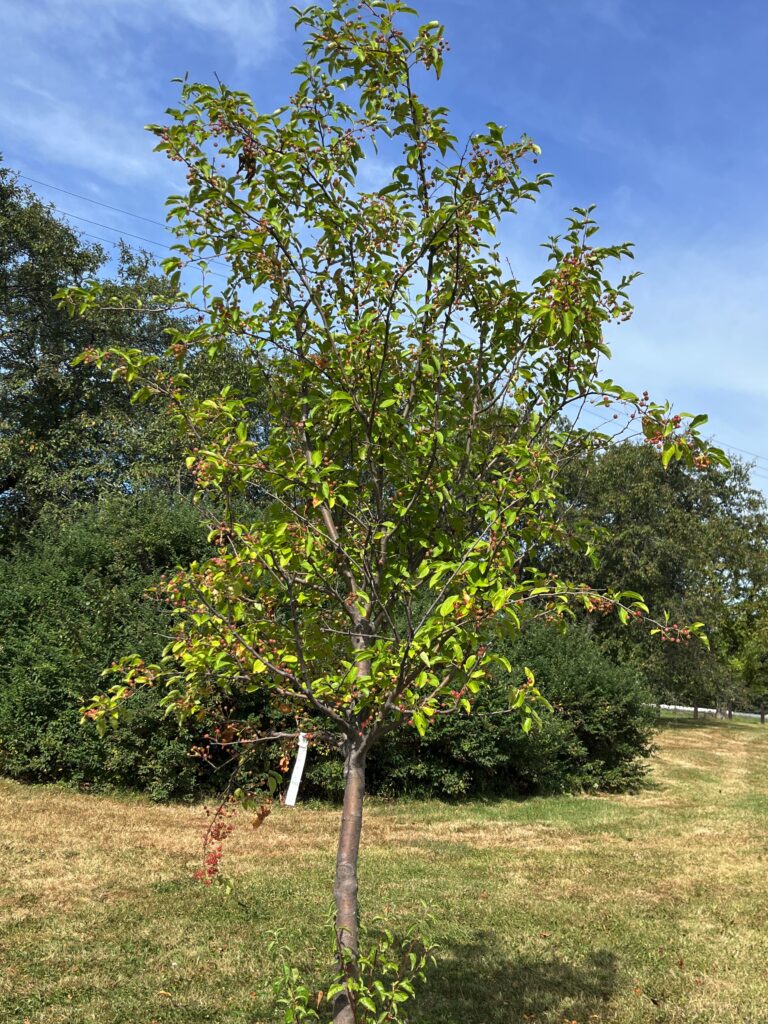Explore the CelebriTrees
Click on a tree in the list below to see a photo of the tree and read the tree species and location descriptions. Click here to learn about the people and events they celebrate and view a map showing the location of the tree.
American Hornbeam [2025]
Amur Chokecherry [2025]
Apollo Sugar Maple [2023]
Autumn Splendor Horse Chestnut [2023]
Autumn Treasure Ironwood [2025]
Black Cherry (1) [2024]
Black Cherry (2) [2024]
Butterflies Magnolia [2024]
Bur Oak (1) [2025]
Bur Oak (2) [2025]
Colorado Spruce [2023]
Crimson Cloud Hawthorn [2024]
Dawn Redwood (1) [2025]
Dawn Redwood (2) [2025]
Emerald Spire Crabapple [2023]
English Oak [2025]
Firefall Maple [2025]
Fraser Fir [2023]
Golden Cascade Linden [2024]
Hardy Rubber Tree [2025]
Harvest Gold Linden [2024]
Imperial Honey Locust [2025]
Ironwood [2024]
Jack Pine [2024]
Jade Prince Dawn Redwood [2025]
Kentucky Coffeetree [2024]
Korean Sun Pear [2025]
Merrill Magnolia [2023]
Northern Pin Oak [2024]
Ohio Buckeye [2023]
Paper Birch (1) [2025]
Paper Birch (2) [2025]
Prairie Sentinel Hackberry [2025]
Rancho Cherry [2023]
Red Fox Katsura [2023]
Red Fox Katsura [2024]
Redmond Basswood [2025]
Red Oak [2023]
Red Rocket Maple [2024]
River Birch (1) [2025]
River Birch (2) [2025]
Ruby Red Horse Chestnut [2023]
Saffron Sentinel Cornelian Cherry [2024]
Shagbark Hickory (1) [2024]
Shagbark Hickory (2) [2024]
Shiloh Splash Birch [2024]
Shingle Oak [2023]
Snowdrift Crabapple [2024]
Sugar Maple (1) [2024]
Sugar Maple (2) [2024]
Summer Cascade River Birch [2023]
Swamp White Oak (1) [2024]
Swamp White Oak (2) [2024]
Tulip Tree [2023]
Upright Eurasian Poplar [2025]
White Oak (1) [2023]
White Oak (2) [2023]
Wildfire Black Gum [2025]
Yellowwood [2025]
Zumi Crabapple [2025]
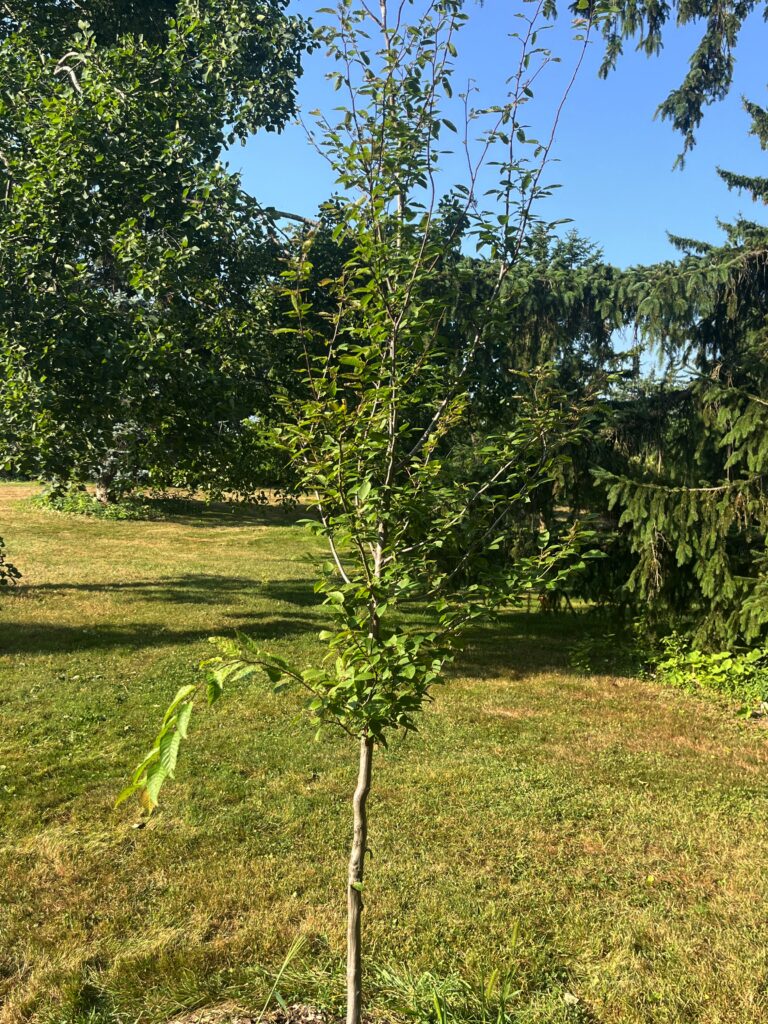
American Hornbeam [2025] — Carpinus caroliniana — This tree is an understorey tree that is native to Ontario and southwest Quebec. The bark is smooth, and on mature trees it’s fluted as if rippling with muscles. This trait leads to other names for the tree, such as Blue-beech and Musclewood. The American Hornbeam tree has an attractive round or flat-topped form. The tree can grow to 10 metres tall. This tree is located next to the Arboretum circle road, nearly across from a path leading down into the wooded area of the Arboretum.
Amur Chokecherry [2025] — Prunus maackii — Amur Chokecherry grows along the banks of the Amur River and neighbouring parts of Asia. It is prized especially for its peeling cinnamon-coloured bark, which stands out even from a distance. The tree also has small fragrant white flowers and black berries that attract birds. Amur Chokecherry is very cold hardy. The tree can grow to 10 metres tall. This tree is located by the fence at the top of the slope, heading down the hill and about 5 metres east of where the south path intersects the Arboretum circle road.
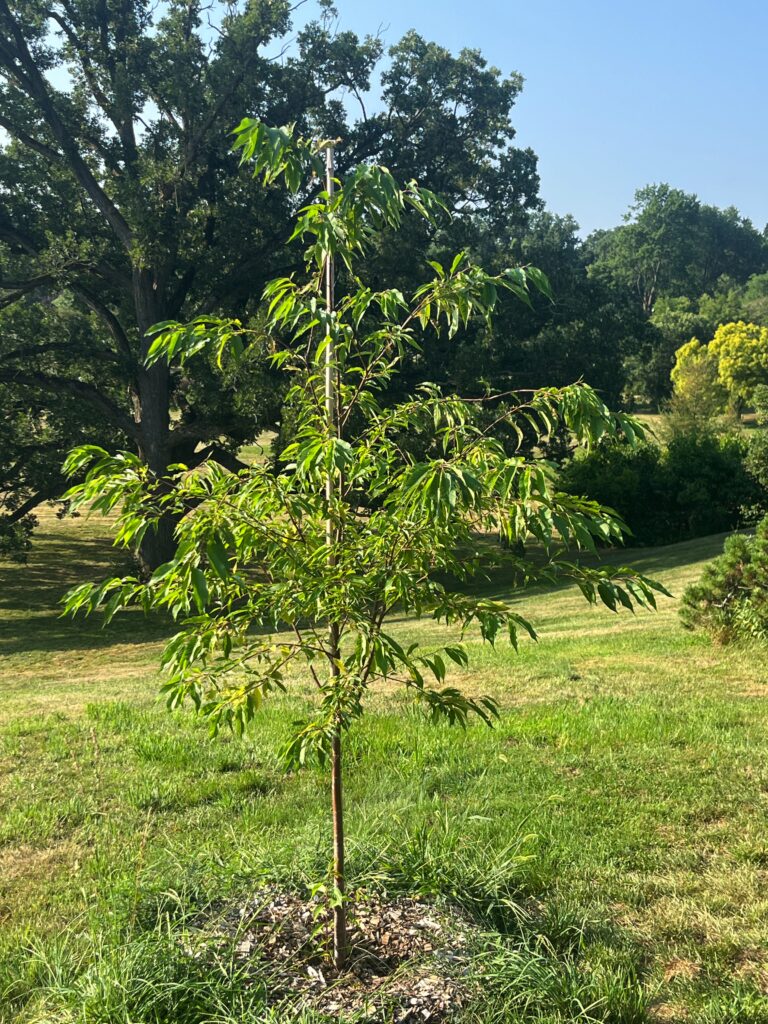

Apollo Sugar Maple [2023] — Acer saccharum ‘Barrett Cole’ — Sugar Maple is the iconic tree of eastern Canada, much loved for its syrup and fall colour. This is an attractive cultivar called Apollo with dense branching and beautiful colour. It stands out in the landscape due to its concise columnar shape, fitting nicely into the landscape. Its fall leaves are described as being “gold to burnt orange.” It grows to about 10 metres at maturity, with a width of about 4 metres. This tree can be found in the maple area along Prince of Wales Drive, about 100 metres south of the roundabout, tucked in behind some tall honey locust trees.
Autumn Splendor Horse Chestnut [2023] — Aesculus x arnoldiana ‘Autumn Splendor’ — A nice hybrid cross between three related North American trees: Ohio, Yellow and Red Buckeyes. Autumn Splendor has short spikes of yellow-red flowers in spring, with maroon red foliage in fall—hence the name. The foliage has good resistance to leaf scorch, which is a common occurrence in Aesculus species. The mature tree has a nice rounded form, about 10 metres tall and wide. This tree is about 10 metres northwest of the Ruby Red Horse Chestnut (see location for that tree), at the side of the circle road.

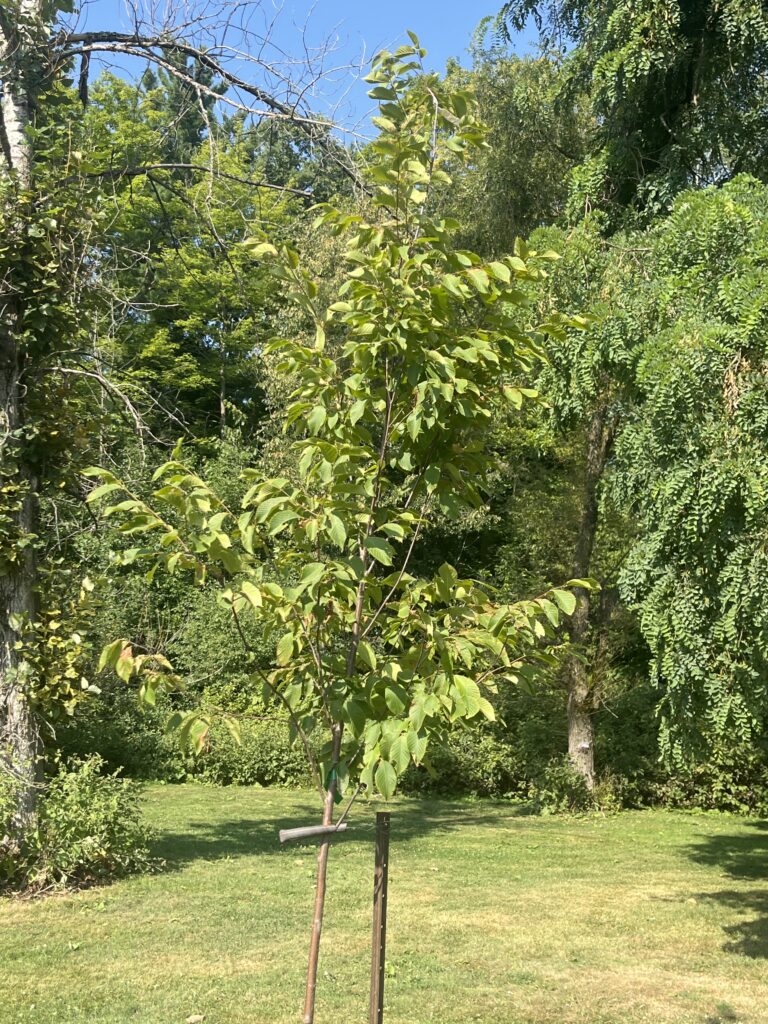
Autumn Treasure Ironwood [2025] — Ostrya virginiana ‘Autumn Treasure’ — Ironwood is a sturdy understorey tree found regularly in the forests around Ottawa. Having no serious pests or diseases, it deserves to be planted more in the city. Its hanging flowers are called catkins, and they develop into hop-like fruits that bear little nutlets sought by birds and other animals. Autumn Treasure is a narrow form of the species, with golden fall colour. The tree can grow to 15 metres tall. This tree is located along the lowland path, about 30 metres southeast of a very large old bur oak.
Black Cherry (1) [2024] — Prunus serotina — Black Cherry is a native tree occasionally found in the forest around Ottawa, but almost never planted in the city. It has short stalks of small white flowers that turn into red-black berrylike fruit. On mature trees, the bark breaks into distinctive square sections. The rich reddish-brown wood of this tree is highly valued for use in cabinetry. This tree is located next to a large rock, near the intersection of the lowland path with a path going into the woodland. The tree can grow to 15 metres or so.


Black Cherry (2) [2024] — Prunus serotina — Black Cherry is a native tree occasionally found in the forest around Ottawa, but almost never planted in the city. It has short stalks of small white flowers that turn into red-black berrylike fruit. On mature trees, the bark breaks into distinctive square sections. The rich reddish-brown wood of this tree is highly valued for use in cabinetry. The tree can grow to 15 metres or so. This tree is located along the lowland path, northwest of Black Cherry (1).
Bur Oak (1) [2025] — Quercus macrocarpa — Bur Oak is a stalwart component of the local forest as well as the urban landscape. It’s been planted in Ottawa’s parks and streets for many years despite its large girth and height. The species grows from New Brunswick to as far west as Alberta, the biggest range of our native oaks. Like other oaks, it is a source of shelter and food for many kinds of wildlife. The tree can grow to 25 metres tall. This tree is located on the east side of the lowland path, about 30 metres southeast of a very large old bur oak.
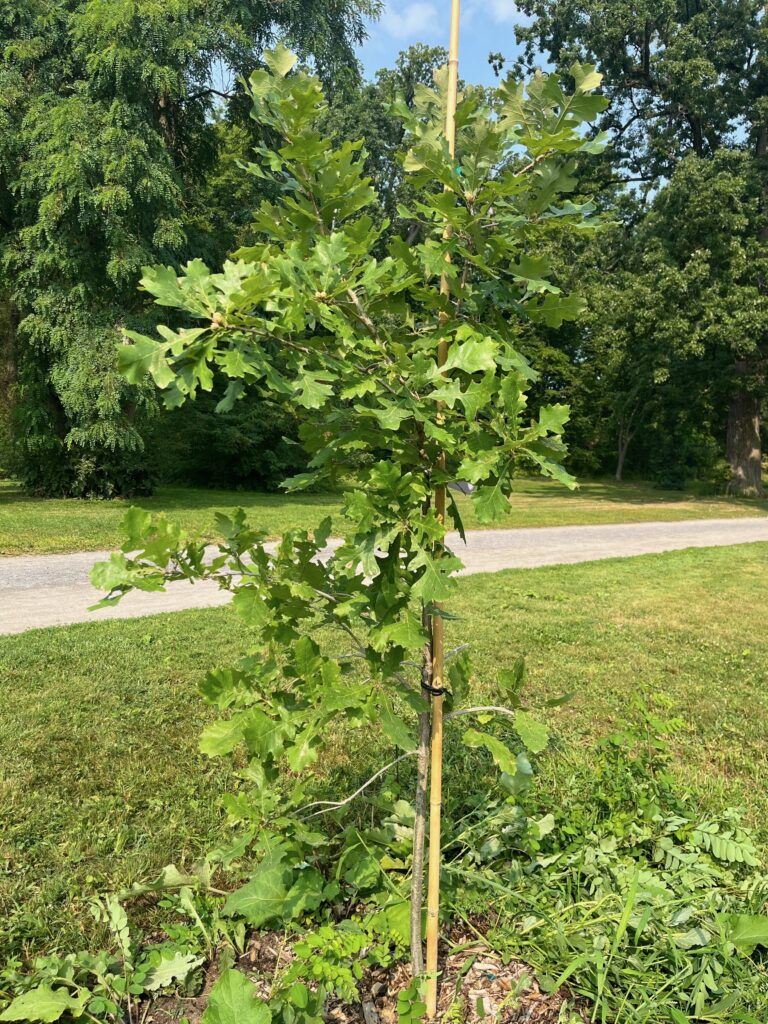
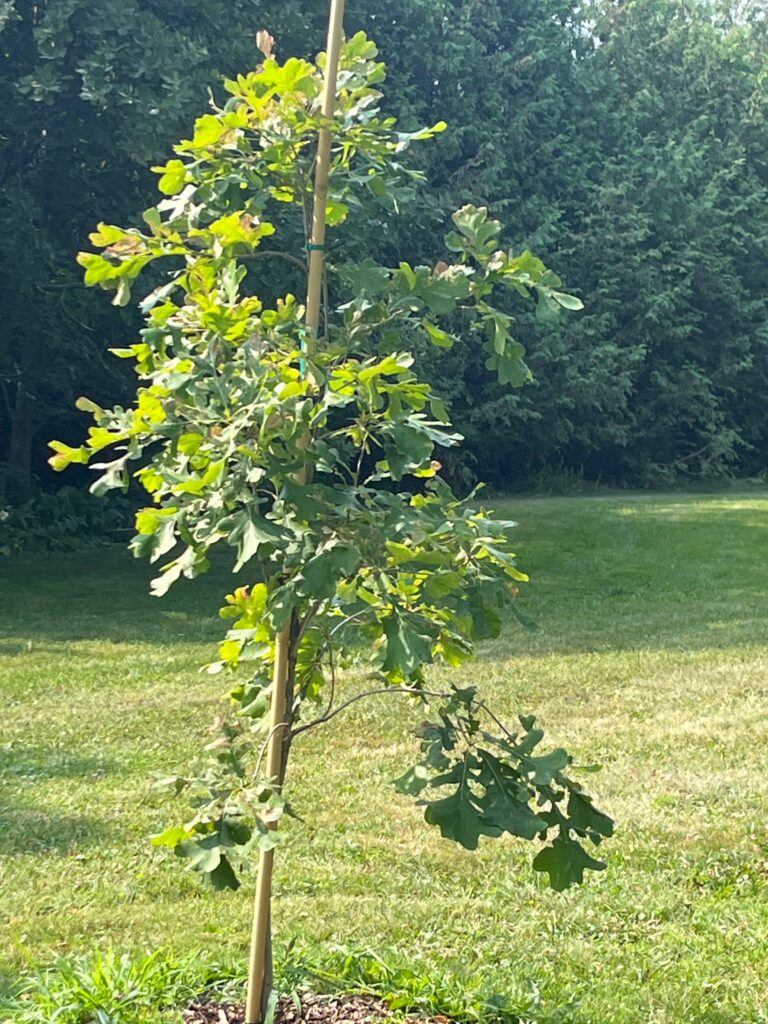
Bur Oak (2) [2025] — Quercus macrocarpa — Bur Oak is a stalwart component of the local forest as well as the urban landscape. It’s been planted in Ottawa’s parks and streets for many years despite its large girth and height. The species grows from New Brunswick to as far west as Alberta, the biggest range of our native oaks. Like other oaks, it is a source of shelter and food for many kinds of wildlife. The tree can grow to 25 metres tall. This tree is located about 20 metres west of the Fletcher Wildlife Garden parking lot entrance to the Arboretum.
Butterflies Magnolia [2024] — Magnolia ‘Butterflies’—Magnolias are always beautiful additions to a landscape, and the flowers of Butterflies Magnolia have an especially luscious yellow colour. The mature flowers also have a lemony scent. This variety is a cross between a native and an Asian Magnolia, and can grow to be a small tree with a central leader, or a multi-stemmed shrub. This tree can grow 5 to 10 metres in height. This tree is located about 50 metres NW of an intersection between paths leading from Dow’s Lake to the Arboretum.


Colorado Spruce [2023] — Picea pungens — This popular western U.S. spruce is planted widely throughout North America for its colour and symmetrical layered form. The dense canopy is thick with stiff and prickly needles. The needle colour ranges from dark green to the silver blue that has identified the species as ‘Blue spruce’ (although some varieties are bluer than others). As the trees mature, the older foliage darkens while the tips of new growth are a contrasting glaucous blue. It can grow as high as 50 metres in the US west but will likely stop at half that height in this site and climate. When grown in the open, Colorado spruce keeps its branches all the way down to the ground. This tree is located in the Arboretum circle, about six metres west of the Fraser Fir (see Fraser Fir location).
Crimson Cloud Hawthorn [2024] — Crataegus laevigata ‘Crimson Cloud’ — Crimson Cloud is a variety of English Hawthorn, a species that is used extensively in hedges and other plantings across Britain. In the spring, this variety is covered with small flowers that are fragrant and en masse look like a red cloud. The variety is also thornless and resistant to the leaf blight that afflicts other trees of this species. The tree usually reaches little more than 5 metres in height. This tree is located about 20 metres SW of the intersection of two paths in the south of the Arboretum.

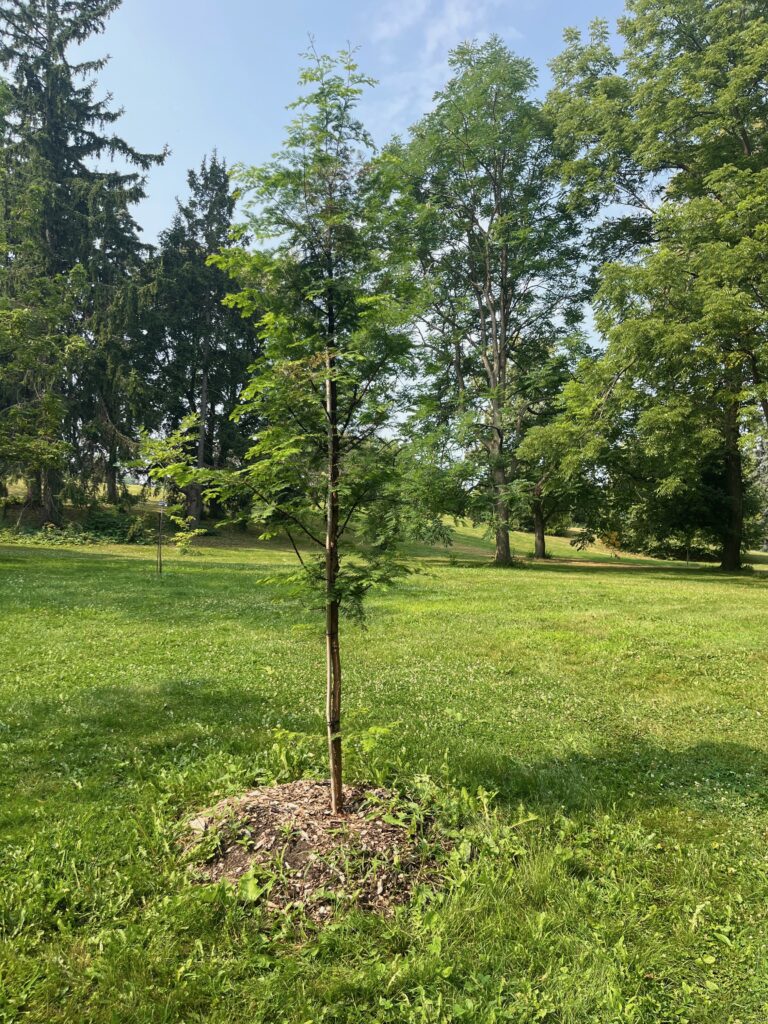
Dawn Redwood (1) [2025] — Metasequoia glyptostroboides — This unique genus is closely related to the Giant Sequoias and Redwoods found in California and, although fossils can be found throughout the northern hemisphere, living specimens were only discovered in China in the 1940’s. It was then introduced to gardens around the world. The tree has a pyramidal shape and attractive feathery foliage that turns reddish brown in the fall. Although the tree can reach 45 metres in a rainforest, in Ottawa it will grow to no more than 25 metres tall. This tree is located in the northern part of the Arboretum, about 30 metres east of a bench.
Dawn Redwood (2) [2025] — Metasequoia glyptostroboides — This unique genus is closely related to Giant Sequoias and Redwoods found in California and, although fossils can be found throughout the northern hemisphere, living specimens were only discovered in China in the 1940’s. It was then introduced to gardens around the world. The tree has a pyramidal shape and attractive feathery foliage that turns reddish brown in the fall. Although the tree can reach 45 metres in a rainforest, in Ottawa it will grow to no more than 25 metres tall. This tree is located on the northeastern tip of Heart Island, reached by a small bridge on its south end.
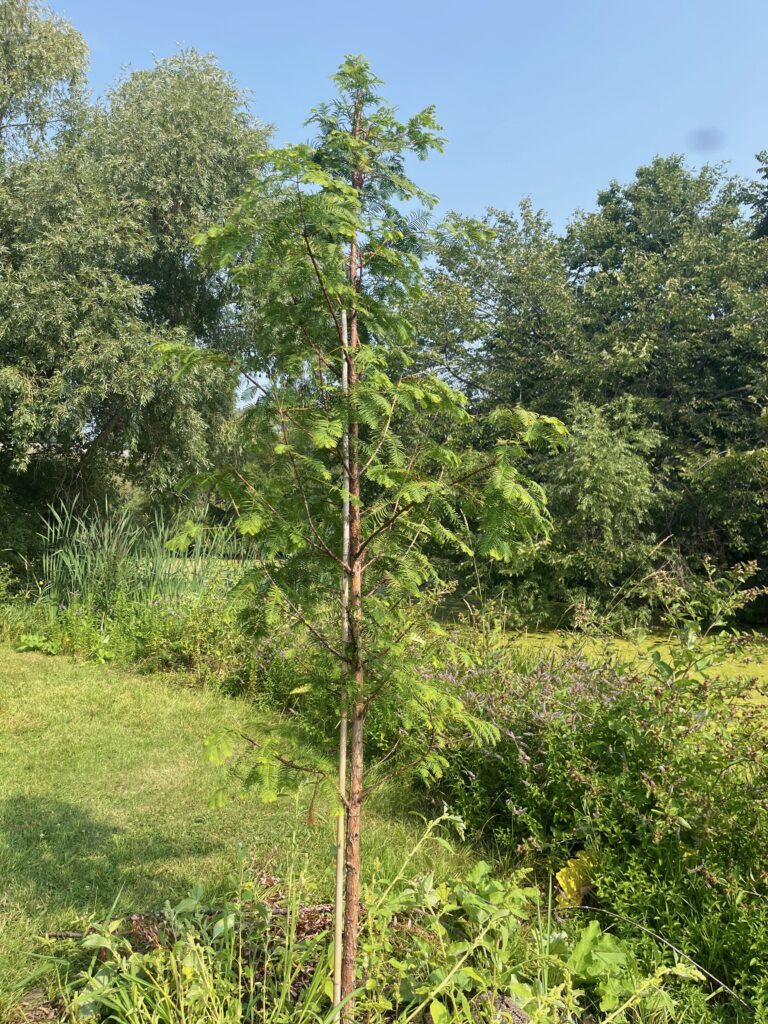

Emerald Spire Crabapple [2023] — Malus x adstringens ‘Jefgreen’ — a variety of Rosybloom Crabapple. The Rosybloom series of crabapples were created by Isabella Preston at the Central Experimental Farm, when there was research being done there on ornamental plants. Emerald Spire has an unusual columnar form and fragrant pink flowers. The leaves turn gold-coloured in the fall. This cultivar was bred at the Agriculture Research Station in Summerland, BC. The mature height is 5 to10 metres, with a spread of a few metres. This tree is planted in an area north of Building 72 amidst many other crabapple trees, about 40 metres west of the path and a little closer to Prince of Wales Drive.
English Oak [2025] — Quercus robur — Although called English Oak, this tree is native to most of Europe and western Asia and is revered for its strength and longevity. The crown of the mature tree is widespread and imposing with long, large branches. English Oak is long-lived and provides shelter and food for many types of wildlife, including insects, birds, and small mammals. The tree can grow to 25 metres tall. This tree is located on the south path, about 30 metres north of the large fenced-in Bebb’s Oak.

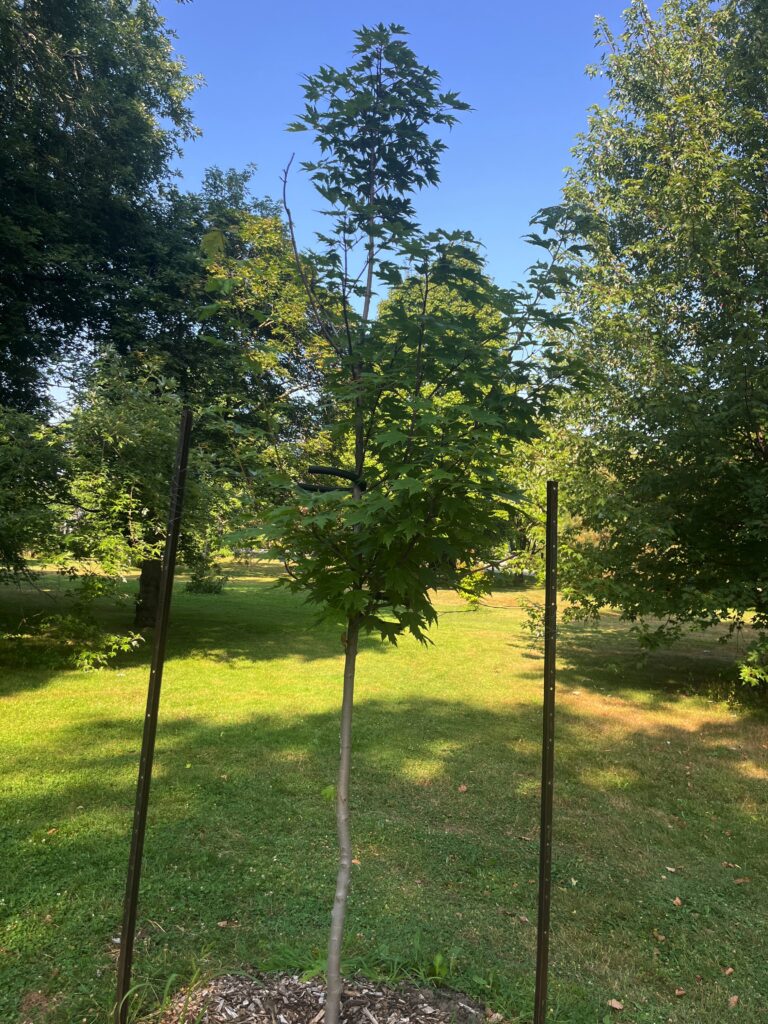
Firefall Maple [2025] — Acer x freemanii ‘Firefall’ — Freeman Maples are hybrids of Red and Silver Maple species, exhibiting some attributes of both species. Red and Silver Maples hybridize naturally, but Freeman Maples are controlled for desired traits. This Firefall cultivar has a strong open crown and is reported to be tolerant of difficult soils and climate conditions. The leaves turn a striking orange red in the fall. The tree grows to about 15 metres tall. This tree is located amongst other maple trees, 30 metres south of the entrance road and about 30 metres west of the Arboretum circle road.
Fraser Fir [2023] — Abies fraseri — This classic conifer with upturned branches is sometimes called ‘Southern Balsam’ since it closely resembles Balsam Fir and grows mainly in the Appalachian Mountains, where it is considered endangered. Fraser Fir is frequently found in damp and fragrant woods in southeastern U.S. along with red spruce and mosses and ferns. In Canada it is grown primarily as a Christmas tree and is greatly preferred for that use due to its long-lasting, fresh-smelling needles. A mature Fraser fir can grow up to 20 metres in height, with a width of up to 10 metres. This tree can be found by following the Arboretum circle road around past the south parking lookout, then going into the circle about 15 metres to a small clearing where it is planted amongst other conifer trees.


Golden Cascade Linden [2024] — Tilia cordata ‘Golden Cascade’ — The linden tree is a very popular street and park tree, and this European species has fragrant flowers that are used for tea and attract bees and other pollinators. There are many varieties of this species, and the Golden Cascade variety is particularly impressive with its weeping branches, and its dark green foliage that turns a nice gold colour in the fall. The tree will grow to about 15 metres in height. This tree is located 40 metres NW of the Building 72 parking lot, about 10 metres east of the path.
Hardy Rubber Tree [2025] — Eucommia ulmoides — This tree is highly valued in its native China where its bark and leaves have been used for medicine for more than 2000 years. The tree’s common name comes from the latex that flows from its leaf veins, but the tree is not related to the famous Rubber Tree of South America, nor to the Gutta-Percha of Asia. It is planted as an ornamental in many arboreta and botanical gardens in Europe and North America. The tree can grow to 15 metres tall. This tree is located down the hill from the north path, about 30 metres east of the bench that sits in the middle of the Arboretum’s northern section.


Harvest Gold Linden [2024] —Tilia mongolica ‘Harvest Gold’ — Linden trees are frequently planted in parks and streets of the city, but Mongolian Linden is a smaller version that can also fit into small landscapes. The Mongolian species has an unusual peeling bark. In addition, this Harvest Gold variety has fragrant yellow flowers and red petioles, and its leaves turn a lovely gold colour in the fall. This tree grows to about 10 metres in height. The tree is located about 40 metres west of a sidewalk that goes from Building 72 to Building 74 in the Arboretum.
Imperial Honey Locust [2025] — Gleditsia triacanthos ‘Impcole’ — Honey Locust has become a very popular street tree worldwide due to its graceful open crown of fine leaflets and its tolerance of many urban problems including drought and salt spray. Although the wild species has formidable thorns growing out of its trunk and branches, the varieties sold by nurseries (including this one) are thornless. The Imperial cultivar has a very regular growth habit with branches that emerge at right angles from the trunk. The tree can grow to 20 metres tall. This tree is located very close to the intersection of the Arboretum’s south path with the downhill path that heads to the east.
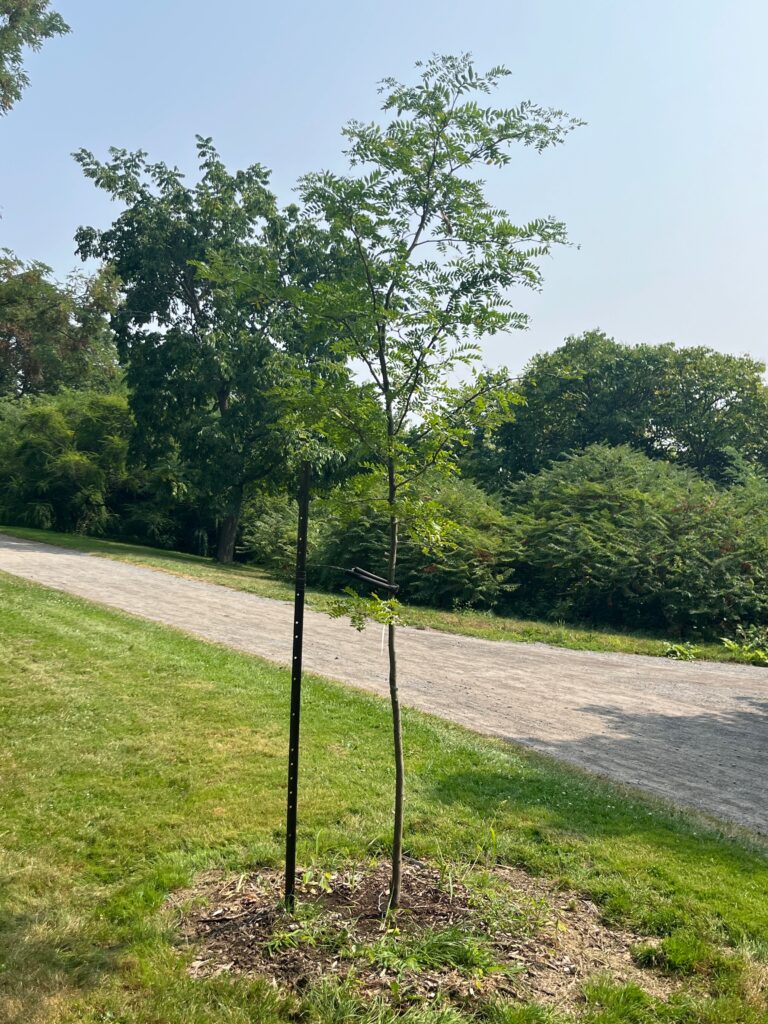

Ironwood [2024] — Ostrya virginiana — Ironwood gets its common name from the hardness of its wood. This native tree is often found in forest understorey around Ottawa, but it is generally overlooked for planting in urban parks and gardens. As it matures, the pyramidal shape becomes more rounded, and the bark takes on an interesting shredded appearance. The tree bears unique clusters of seed pods that somewhat resemble hops (The tree is sometimes called ‘Hop-Hornbeam’). Ironwood trees can grow to about 10 metres in height. This tree is located at the foot of a path that goes up into the woodland of the Arboretum.
Jack Pine [2024] — Pinus banksiana — Jack Pine is the iconic Algonquin Park tree featured in a painting by Tom Thomson, of the Group of Seven. This species is not commonly planted in cities, but is very cold-hardy and grows in the boreal as well as in hardwood forests. The cones are sealed shut with resin and only open under intense heat, making the tree a pioneer species that can repopulate areas ravaged by fire. Jack Pine can grow to be about 20 metres tall, although that will vary depending on the site. This tree is located along the lowland path, about 50 metres north of the intersection with a path going into the woodland.

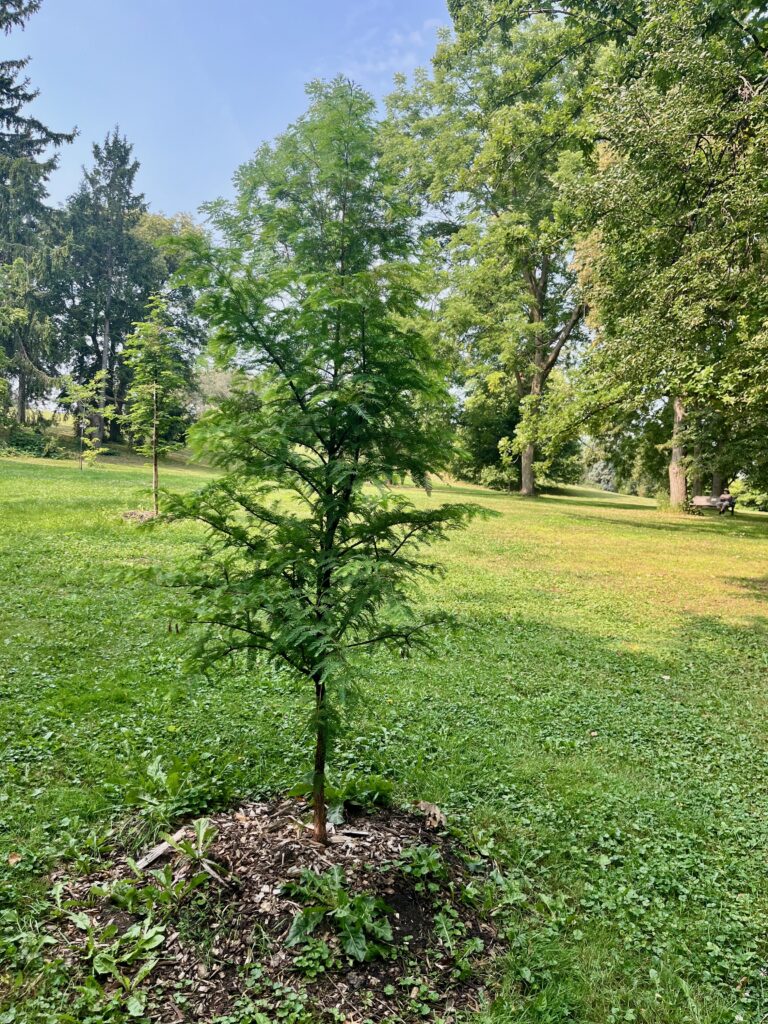
Jade Prince Dawn Redwood [2025] — Metasequoia glyptostroboides ‘Jade Prince’ — Jade Prince is a cultivar of the Dawn Redwood (see Dawn Redwood species description) with slightly more compact and evenly spaced branching and beautiful fall colours. Although the tree can grow to 45 metres height in rainforest conditions, it will grow to about 25 metres tall in Ottawa. This tree is located in the middle of the northern part of the Arboretum, about 20 metres east of a bench.
Kentucky Coffeetree [2024] — Gymnocladus dioicus— This attractive tree is rarely found in natural landscapes, but deserves to be planted more widely for its imposing form and unusual features. Among its distinctive traits are the foliage: large doubly compound leaves, and the fruit: big leathery pods. Kentucky Coffeetree is very cold-hardy and can tolerate most urban growing conditions. Kentucky Coffeetree can grow up to 25 metres in height. This tree is located about 50 metres SW of the intersection of two paths in the south of the Arboretum.

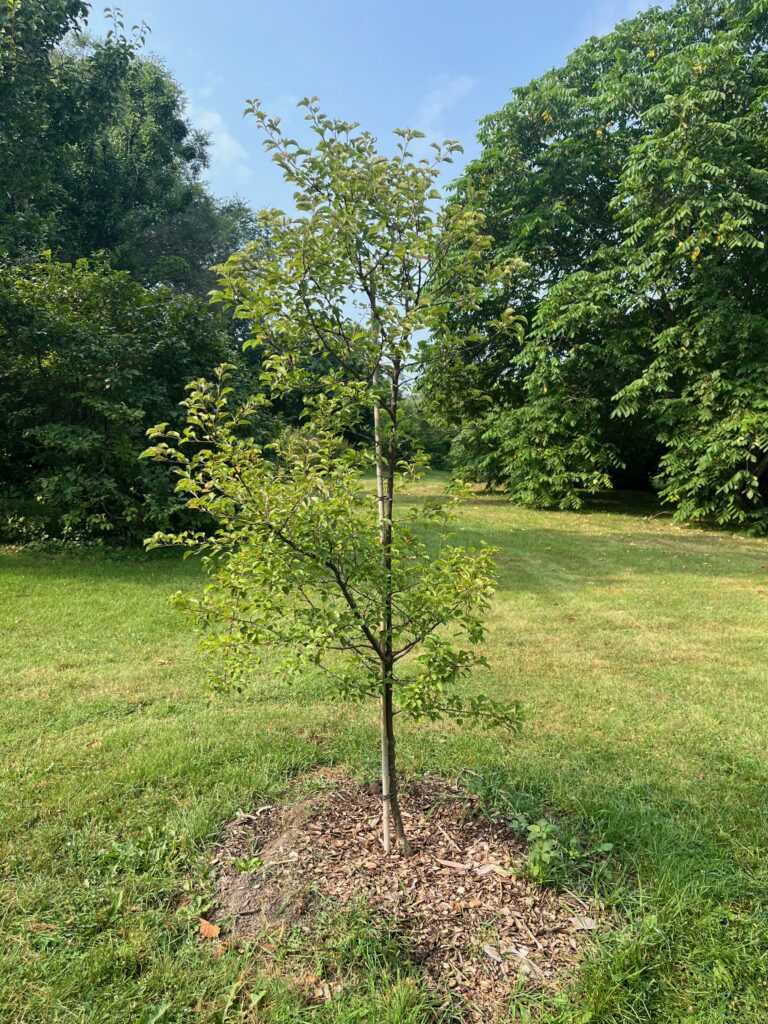
Korean Sun Pear [2025] — Pyrus fauriei ‘Westwood’ — This is a small ornamental pear tree native to Korea. The tree has a compact rounded form and is very cold hardy. The flowers and fruit are quite small, but they are attractive as they appear in masses on the tree. The Korean Sun variety was selected for its attractive autumn colours of red, yellow, and orange. The tree can grow to a little over 5 metres tall. This tree is located along the path at the north end of the Arboretum, about 60 metres east of the point where the path meets Prince of Wales Drive.
Merrill Magnolia [2023] — Magnolia x loebneri ‘Merrill’ — ‘Merrill’ is a cross between two Japanese species: Magnolia stellata (star magnolia) and Magnolia kobus (Kobus Magnolia). It has fragrant white star-shaped flowers with yellow eyes, and the flowers are less susceptible than other magnolias to late frosts. The fruits are showy pink pods. Merrill Magnolia has a low wide canopy and can grow about 10 metres tall with a spread of 10 metres. This tree is located between Buildings 72 and 74, about 10 metres from the small walkway between the two buildings.


Northern Pin Oak [2024] — Quercus ellipsoidalis — Northern Pin Oak is an attractive shade tree, native to southern Ontario. Its widely lobed leaves come out red in the spring, change to shiny green and then turn a dark red, orange or brown in the fall. Its acorns provide food for wildlife. This oak has hard and strong wood suitable for flooring, furniture, and other applications. It will grow to about 15 metres when mature. This tree is located about 60 metres north of the gate at the north end of the Building 72 parking lot, in an opening at the bottom of the hill.
Ohio Buckeye [2023] — Aesculus glabra — Buckeye is a North American tree that is closely related to European horse chestnut trees. The Aesculus genus is noted for the spike of showy flowers in the spring and large whorl of leaves in the summer. Ohio Buckeye leaves may turn pumpkin-orange in the fall, although the colour is variable. Although this tree isn’t commonly planted this far north, it has been shown to be hardy in Ottawa. When it matures, it’s a very pleasant shade tree with round canopy.Its mature height is approximately 10 metres, and its spread about the same. This tree is about 12 metres east of the Ruby Red Horse Chestnut (see location for that tree) where it is planted near some pines and junipers.

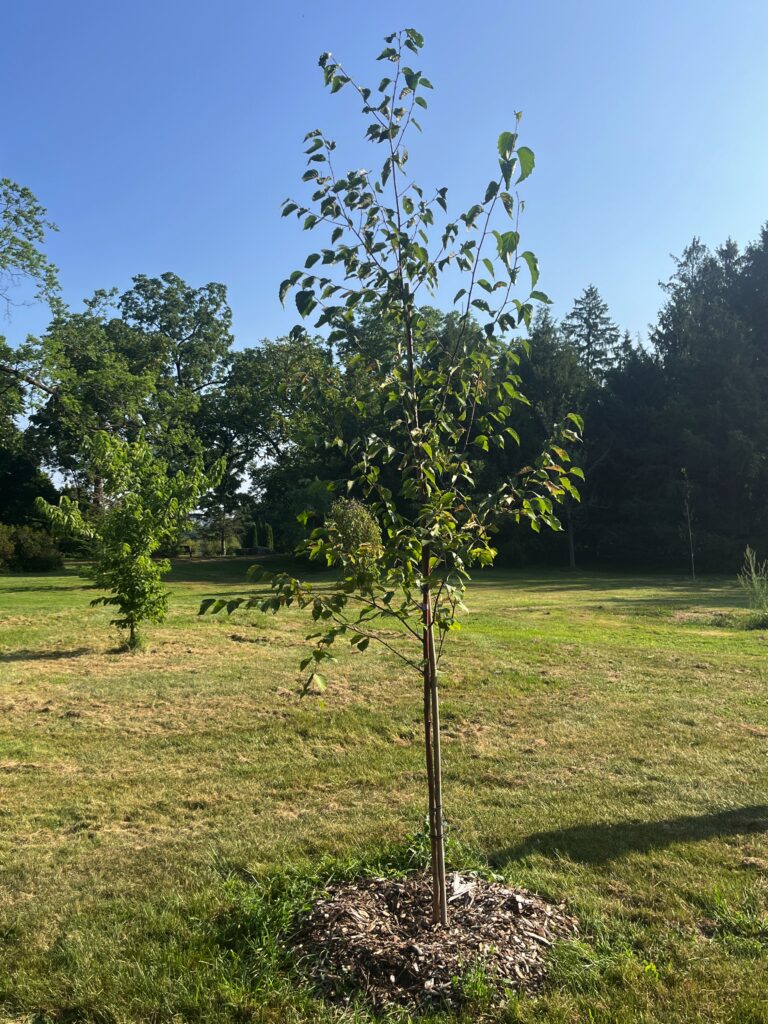
Paper Birch (1) [2025] — Betula papyrifera — Paper Birch (or White Birch) is the iconic tree of the north, ranging from sea to sea to sea in Canada. All Canadians know of its use by the indigenous people in canoes, baskets, bags, and other essential things. It’s a pioneer, one of the first trees to grow back on disturbed sites. The bark starts out a dark red colour, turning white after several years. The fall leaf colour is bright yellow. The tree can grow to 20 metres tall. This tree is located about 100 metres south of the bench in the Arboretum circle, about 25 metres west of Paper Birch (2).
Paper Birch (2) [2025] — Betula papyrifera — Paper Birch (or White Birch) is the iconic tree of the north, ranging from sea to sea to sea in Canada. All Canadians know of its use by the indigenous people in canoes, baskets, bags, and other essential things. It’s a pioneer, one of the first trees to grow back on disturbed sites. The bark starts out a dark red colour, turning white after several years. The fall leaf colour is bright yellow. The tree can grow to 20 metres tall. This tree is about 100 metres south of the bench in the Arboretum circle, about 25 metres east of Paper Birch (1).
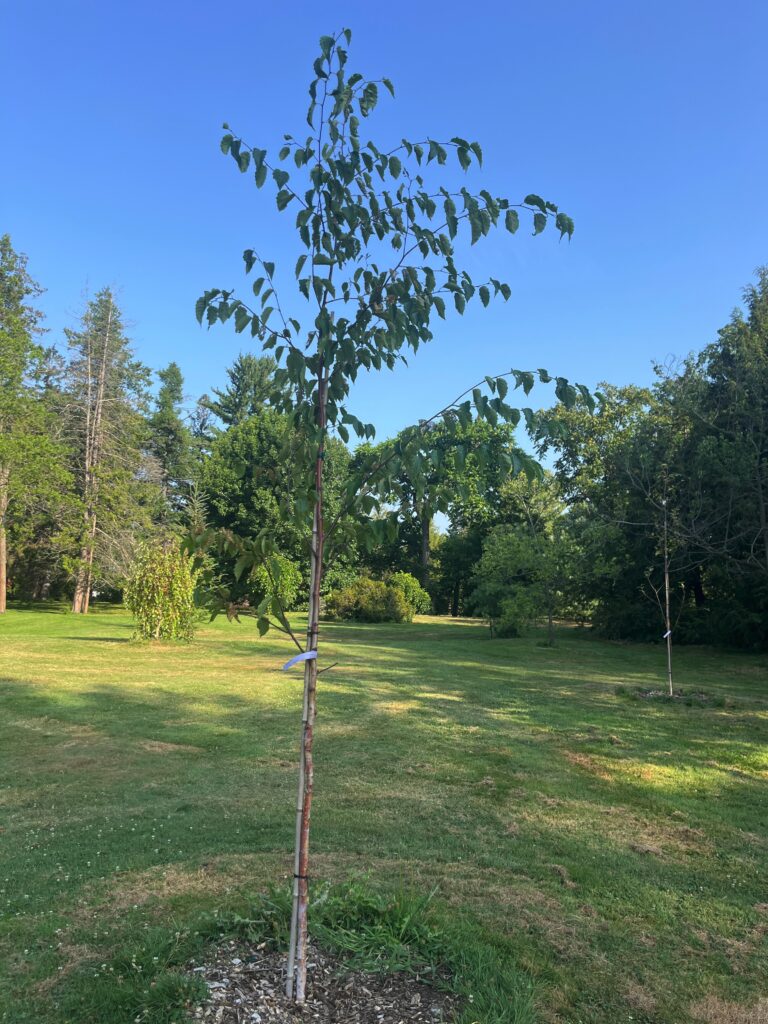
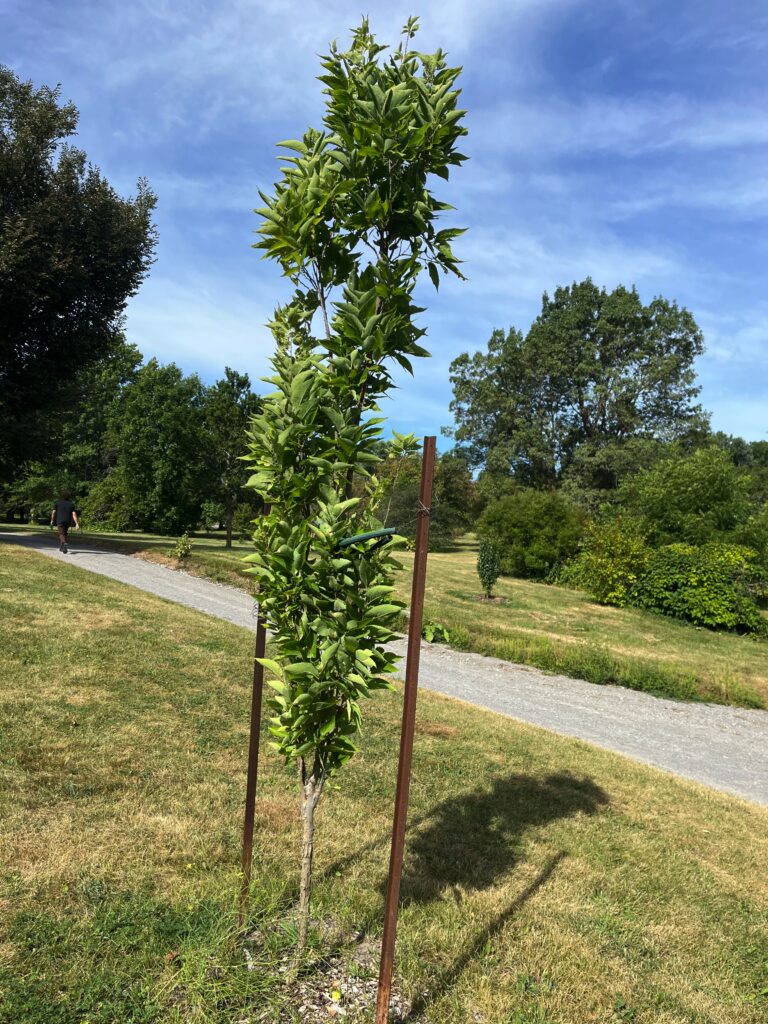
Prairie Sentinel Hackberry [2025] — Celtis occidentalis ‘Prairie Sentinel’ — Hackberry is a native North American tree that just barely made it into Canada at Ontario’s southern tip. Yet it can survive extreme conditions of cold and drought and is now being planted extensively in Canadian cities. Prairie Sentinel is a fast-growing cultivar that was cloned from a tree found in the United States prairies. It grows into a tall columnar form. The leaves turn yellow in the fall. The tree can grow to 20 metres tall. This tree is located right at the southwest corner between the lowland path and the south path.
Rancho Cherry [2023] — Prunus sargentii ‘Rancho’ — This is an upright-to-rounded cherry tree with beautiful pink flowers that come out before the leaves in early spring. The Rancho variety is an American clone of a beautiful Japanese cherry tree. The bark takes on a glossy red colour, and the leaves turn a bronze colour in the fall. Rancho is more resistant than many other cherries to disease and weather conditions. Rancho cherry will grow to about 8 metres tall at maturity, with a spread of 4 metres. This tree is planted not too far off the north path that runs from Building 72 toward Preston Street. It is located down the hill on the right side as you go north, about 40 metres north of the Katsura tree next to the path.


Red Fox Katsura [2023] — Cercidiphyllum japonicum ‘Rotfuchs’ — This is a purple-leaved cultivar of a very popular Japanese tree. The shape of the Red Fox cultivar is narrow and columnar. The leaf colour changes to bluish green in summer and then orange-red in fall. Katsura trees are also noted for their ‘cotton candy’ odor in the fall. The mature height of this tree is about 15 metres. This tree is located about 40 metres east of the intersection of the Circle road with the entrance way.
Red Fox Katsura [2024] — Cercidiphyllum japonicum ‘Rotfuchs’—This is a purple-leaved cultivar of a very popular Japanese tree. The shape of the Red Fox cultivar is narrow and columnar. The leaf colour changes to bluish green in the summer and then orange-red in the fall. Katsura trees are also noted for their “cotton candy” odour in the fall. The mature height of this tree is about 15 metres. This tree is located on the right side of the north path leading from Building 72 toward Preston Street, about 40 metres from the path gate.

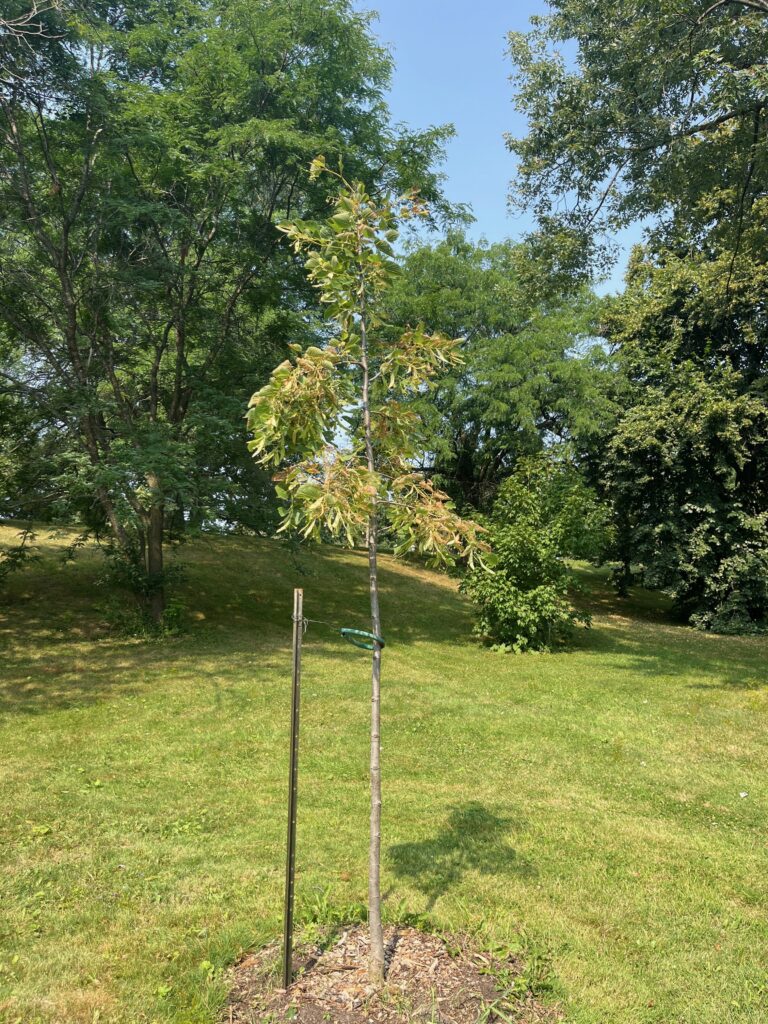
Redmond Basswood [2025] — Tilia americana ‘Redmond‘ — Basswood is often found in local hardwood forests along with maple, beech, and birch trees. It grows quickly into a tall tree with many large leaves providing lots of shade. Its flowers, seeds, and leaves provide food for wildlife. The Redmond variety of Basswood has dense branches that are slightly more upright than the species form. The tree can grow to 20 metres tall. This tree is located between the two south paths, in an open area that is right at the bottom of the hill.
Red Oak [2023] — Quercus rubra — This beautiful and hardy native species is a popular shade tree. In the open, it has a more rounded form than most oak trees; in the forest, it grows tall and straight. Its leaves emerge with a bronze-red colour, and turn a deep scarlet in the fall. Red oak is an important lumber tree used for furniture and flooring among other applications, and many birds and mammals feed on the acorns. Red oak can grow to 20 metres in height and width. This tree is planted right next to the path that runs southeast toward the canal, down in the lowland area just west of the Arboretum’s little island. Follow the path past the intersection with the other paths, a little further along from the bench up on the hill, and look for the tree on the left side of the path.


Red Rocket Maple [2024] — Acer rubrum ‘Red Rocket’ — Red Maple is one of the most loved Canadian trees in autumn, with its fiery red leaf display. The Red Rocket variety has beautiful red flowers as well as fall colour, and has a narrow form that can fit into small yard spaces or be planted in line as a screen along a road or pathway. The tree grows to about 10 metres in height. This tree can be found by following the Arboretum circle road to the path that heads south toward Fletcher Wildlife Garden. It’s planted about 5 metres west of the path.
River Birch (1) [2025] — Betula nigra — Although the normal range for River Birch is south of the Canadian border, its cold hardiness and heat tolerance suit Ottawa conditions well. It’s also resistant to pests including the bronze birch borer which plagues other birch species. River Birch is an attractive round tree with very interesting bark that peels to show a pink salmon colour on the branches. The tree can grow as high as 20 metres. This tree is located just inside the Arboretum Circle Road, about 15 metres along the road from where the entrance road turns right to follow the Arboretum circle road.
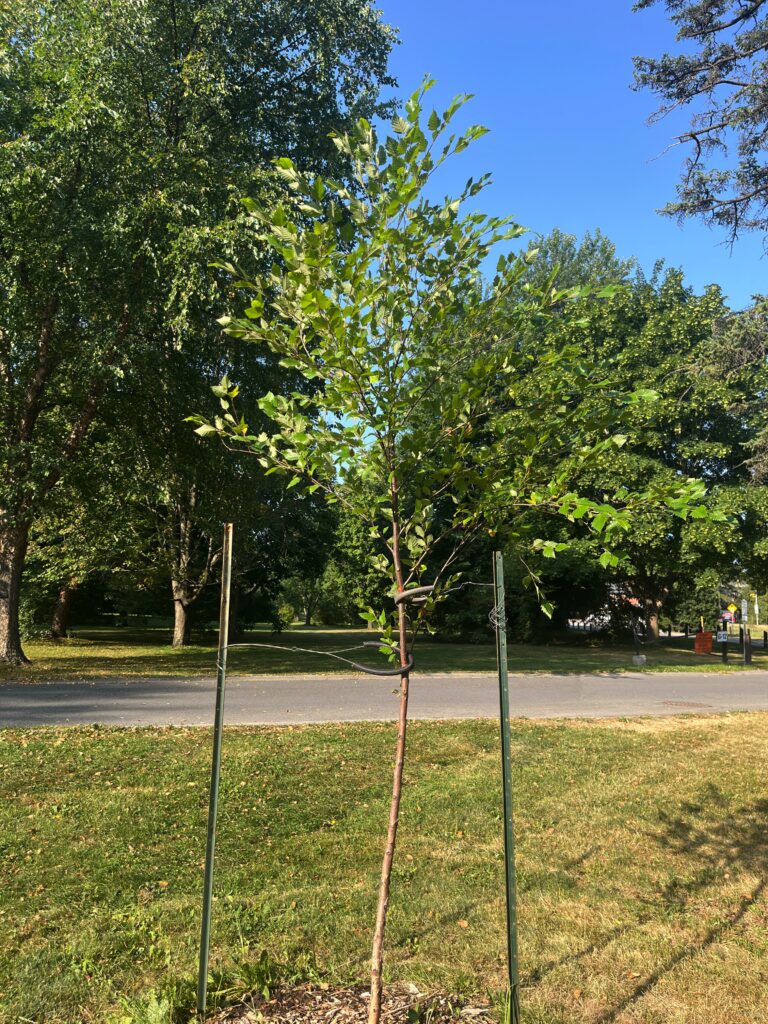
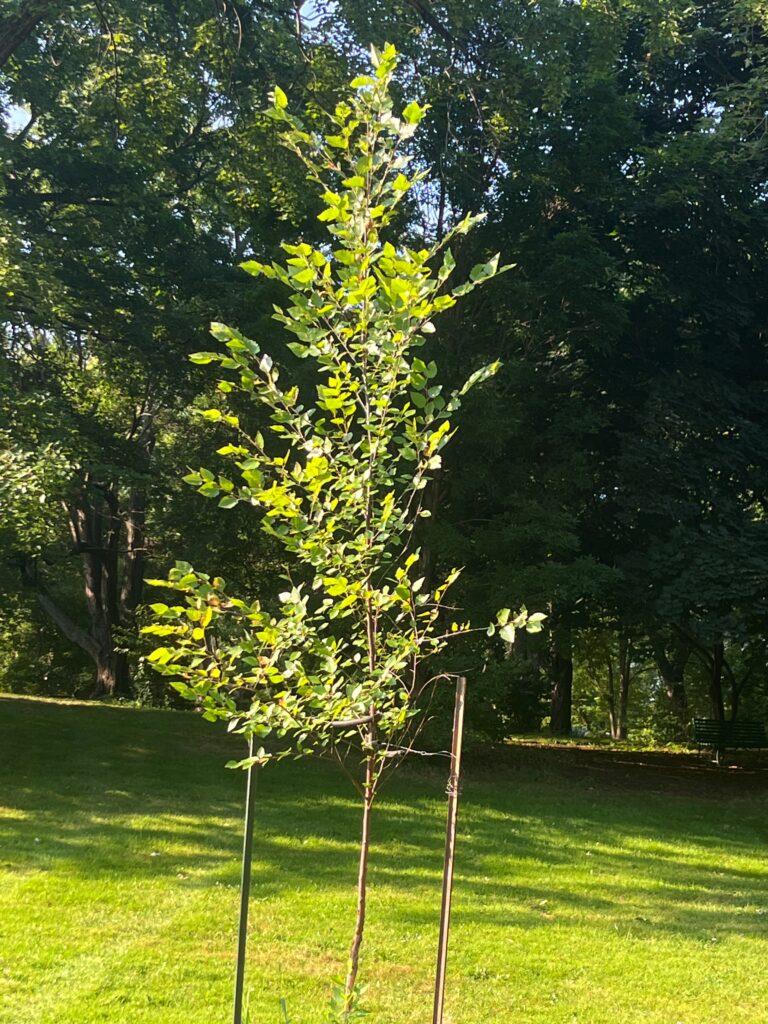
River Birch (2) [2025] — Betula nigra — Although the normal range for River Birch is south of the Canadian border, its cold hardiness and heat tolerance suit Ottawa conditions well. It’s also resistant to pests including the bronze birch borer which plagues other birch species. River Birch is an attractive round tree with very interesting bark that peels to show a pink salmon colour on the branches. The tree can grow as high as 20 metres. This tree is located across the Arboretum circle road and about 20 metres south from River Birch (1).
Ruby Red Horse Chestnut [2023] — Aesculus x carnea ‘Briotii’ — Ruby Red Horse chestnut is a hybrid between the North American red buckeye and the European horse chestnut. In the spring, it has beautiful large panicles of red flowers. Briotii is a cultivar with even larger, darker red flowers. The leaves, like those of other buckeyes and horse chestnuts, radiate in distinctive whorls of several leaflets.Ruby Red Horse Chestnut grows to about 10 metres tall, with a dense, broadly round canopy. This tree can be found by following the Arboretum circle road about 140 metres until you get to the gate on the right hand side; the tree is on the opposite side, across from the gate.


Saffron Sentinel Cornelian Cherry [2024] —Cornus mas ‘Saffron Sentinel’—Cornelian Cherry Dogwood is especially known for its bright yellow flowers that are among the first things to blossom in the spring. It also bears tart fruit used in jam, and is very resistant to disease and pests. The Saffron Sentinel variety is columnar in shape and has dark green foliage in the summer. The tree grows to about 5 metres or so. This tree is located next to the sidewalk between Buildings 72 and 74.
Shagbark Hickory (1) [2024] — Carya ovata — Hickories are prized native trees in the North American forest, and Shagbark is one of the best of the hickory genus for its appearance and form. Although it generally grows south of the US border, isolated stands of Shagbark Hickory have been found in places near Ottawa. This species has a straight trunk and shapely crown, and mature trees have the interesting bark feature that gives them their name. Shagbark Hickory can reach 25 metres in height. This tree is located in the northern part of the Arboretum, about 20 metres east of the north path and about 100 metres south of the Prince of Wales crosswalk.
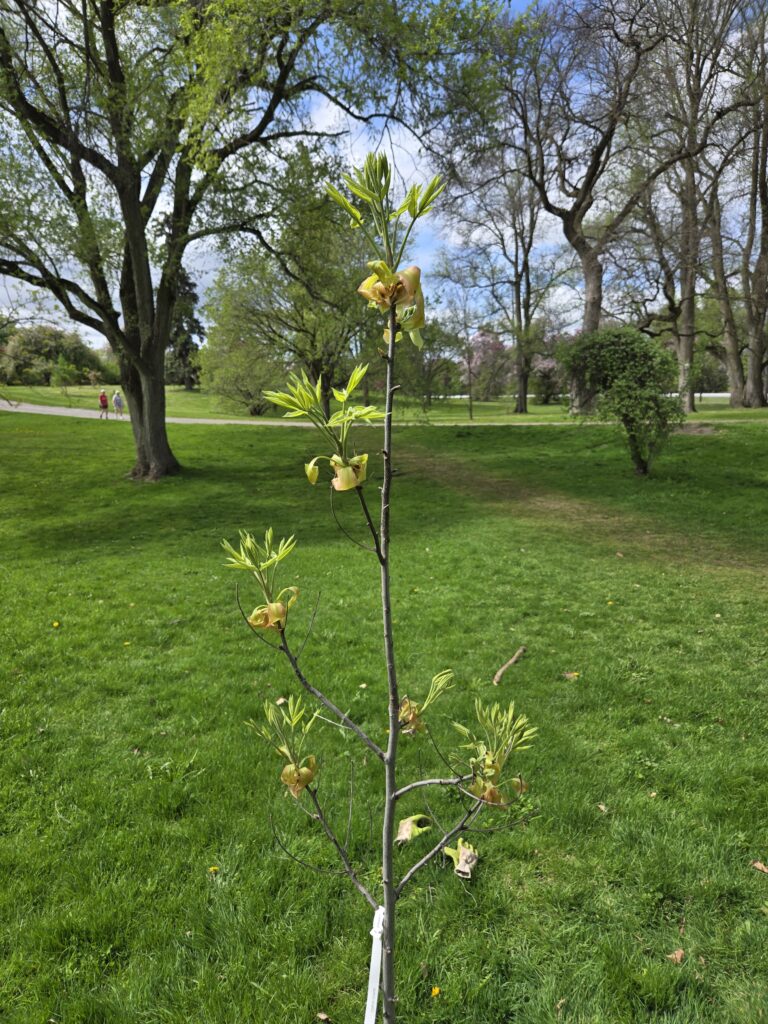

Shagbark Hickory (2) [2024] — Carya ovata — Hickories are prized native trees in the North American forest, and Shagbark is one of the best of the hickory genus for its appearance and form. Although it generally grows south of the US border, isolated stands of Shagbark Hickory have been found in places near Ottawa. This species has a straight trunk and shapely crown, and mature trees have the interesting bark feature that gives them their name. Shagbark Hickory can reach 25 metres in height. This tree is located next to a donor bench along the pathway, about 80 meters SE of the intersection of the path with another pathway.
Shiloh Splash Birch [2024] — Betula nigra ‘Shiloh Splash’ — Shiloh Splash is a variety of the hardy River Birch, an underutilized birch species for growing in Ottawa. It is a good selection for urban planting, not being affected by major pests that attack other birches. This cultivar, first discovered at a nursery in North Carolina, is named for its interesting leaves that are splashed with white colour. This is a small but striking tree, growing only about 5 metres tall. This tree is located about 35 metres south of the intersection of the Arboretum circle road with the entrance road.


Shingle Oak [2023] — Quercus imbricaria — At first glance, this tree doesn’t seem like an oak to many people because the whole, lustrous leaves aren’t cut into lobes like a typical oak leaf. However, the tree itself is very like an oak in size and presence, becoming more impressive and distinctive as it ages, with wide-spreading thick branches. Native to the Us Midwest, it is growing further north as the climate becomes warmer. Shingle Oak grows to be 15 to 20 metres high, 5 to 10 metres wide. This tree is located about 20 metres southwest of the nearby White Oak (see location for White Oak(2)).
Snowdrift Crabapple [2024] — Malus ‘Snowdrift’ — Crabapple trees come in many different shapes and sizes. The Snowdrift variety has a consistent rounded form, filled with a dense canopy and dark green leaves. In the spring it has nice pink buds that turn into bright white flowers. The leaves have a yellow colour in the fall. The orange-red fruit attracts birds through the winter. It will grow to about 5 metres in height. This tree is located about 30 metres NW of the parking lot around Building 72 in the Arboretum.


Sugar Maple (1) [2024] — Acer saccharum — No tree is more Canadian than Sugar Maple, and it is a very familiar sight in forests around Ottawa. It is valued highly for its sweet-tasting sap, its finely grained but tough wood, and especially for its fall display of orange, red and yellow colours. This species is native to cool climates, needing cold weather during its dormant period. Sugar Maple reaches about 20 metres in height, although it can be taller in the forest. This tree is located next to the lowland path that tracks beside the woodland area of the Arboretum, about 120 metres SE of the intersection with multiple paths leading to Dow’s Lake and other places.
Sugar Maple (2) [2024] —Acer saccharum – No tree is more Canadian than Sugar Maple, and it is a very familiar sight in forests around Ottawa. It is valued highly for its sweet-tasting sap, its finely grained but tough wood, and especially for its fall display of orange, red and yellow colours. This species is native to cool climates, needing cold weather during its dormant period. Sugar Maple reaches about 20 metres in height, although it can be taller in the forest. This tree is located near the lowland path that tracks beside the woodland area of the Arboretum, about 20 metres northwest of Sugar Maple (1).


Summer Cascade River Birch [2023] — Betula nigra ‘Summer Cascade’ — River Birch is a resilient tree that should be planted more often in cities due to its resistance to heat and disease. Native to the eastern US, it is hardy here in Ottawa. The bark on young stems and branches turns an attractive salmon colour and, like on other birches, peels away over time. Weeping River Birch grows to be a graceful relatively small tree, typically 10 metres high. The older bark changes to a darker colour and is transformed into irregular plates. This tree is located on the little island in the Arboretum; go over the bridge onto the island and head left past a paper birch tree.
Swamp White Oak (1) [2024] — Quercus bicolor — This tree wasn’t thought to be native to this region until a few very mature trees were found not far from Ottawa. They can grow to an impressive size, with long coarse branches extending out from wide trunks. Like other oaks, this species is important to the ecology due to features that feed or shelter a lot of wildlife. Swamp White Oak can be identified by its leaves, dark green above and light-coloured underneath. The tree grows to about 20 metres tall. This tree is located about 90 metres north of the North Lookout parking area, near the old windbreak of conifers.


Swamp White Oak (2) [2024] — Quercus bicolor — This tree wasn’t thought to be native to this region until a few very mature trees were found not far from Ottawa. They can grow to an impressive size, with long coarse branches extending out from wide trunks. Like other oaks, this species is important to the ecology due to features that feed or shelter a lot of wildlife. Swamp White Oak can be identified by its leaves, dark green above and light-coloured underneath. The tree grows to about 20 metres tall. This tree is located at the bottom of the South Lookout, 10 metres east of the lowland path, and 5 metres away from a donor bench.
Tulip Tree [2023] — Liriodendron tulipifera — Tulip Trees are iconic tall trees in southwestern Ontario and in the northeastern US, but are rare to be seen in eastern Canada. They are named for their distinctive tulip-shaped leaves. They also have interesting tulip-shaped flowers of yellow, orange and green. The leaves turn an attractive yellow in the fall. They are sometimes called “Yellow Poplar”. Tulip Trees are capable of growing straight and tall (25 metres) in prime locations. This tree is located in the northern part of the Arboretum, on a small rise just south of the magnolia area, about 40 metres east of the north path.

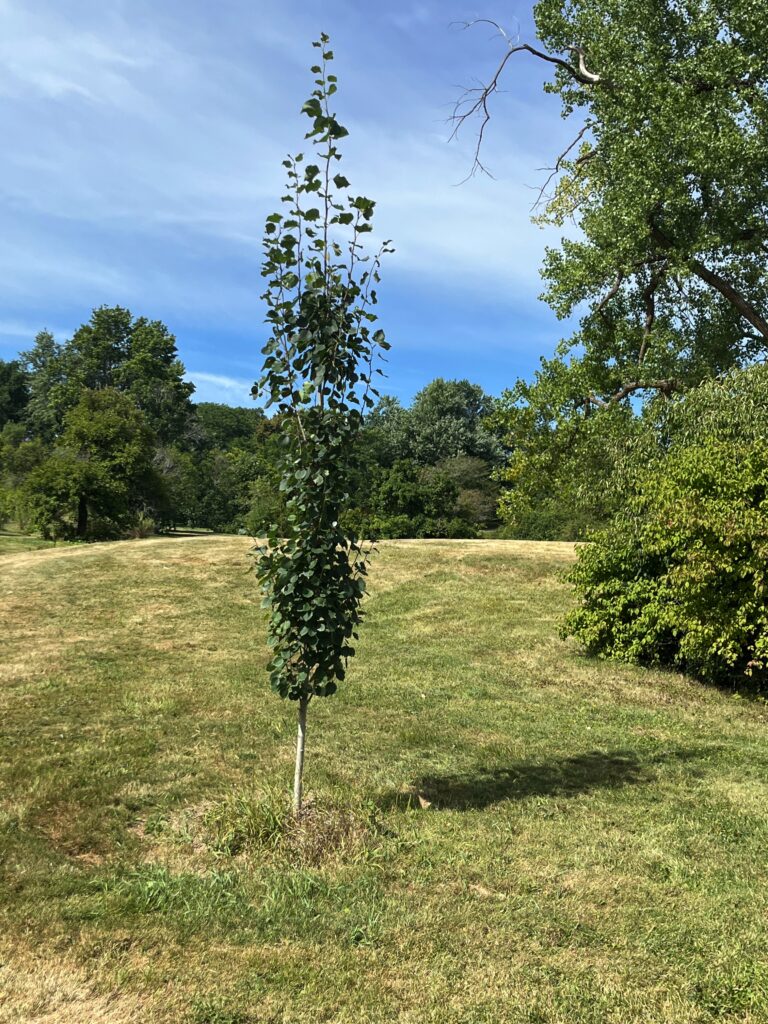
Upright Eurasian Poplar [2025] — Populus tremula ‘Erecta’ — This tree is a cultivar of a very widespread poplar species. Eurasian Poplar is nearly identical to its North American counterpart, Trembling Aspen, and is just as cold-hardy. The Erecta form is distinctively narrow and tall. Since it’s a male clone, it doesn’t produce the cottony seeds that sail from poplars in the spring. The leaves turn bright yellow in the fall. The tree can grow to 10 metres tall. This tree is located 25 metres west of the lowland path, and 20 metres north of the path that splits off the south path and comes down the hill.
White Oak (1) [2023] — Quercus alba — This is the most impressive of the native oaks, growing in the southern parts of Ontario and Quebec but rare to find as far north as Ottawa. In an open setting, the tree spreads its branches wide and its outline becomes more rounded with age. The dark green leaves turn russet colour in the fall, and the bark is light coloured and scaly. White Oak wood is valued highly and used for furniture, flooring, barrels and many other applications. White Oak can grow to about 15 to 20 metres in height. This tree is planted along the path at the bottom of the woodland area in the Arboretum. It is located across from a service building, about 60 metres south of the junction where four paths intersect, and 20 metres north of a big Bur Oak.


White Oak (2) [2023] — Quercus alba — This is the most impressive of the native oaks, growing in the southern parts of Ontario and Quebec but rare to find as far north as Ottawa. In an open setting, the tree spreads its branches wide and its outline becomes more rounded with age. The dark green leaves turn russet colour in the fall, and the bark is light coloured and scaly. White Oak wood is valued highly and used for furniture, flooring, barrels and many other applications. White Oak can grow to about 15 to 20 metres in height. This tree is planted next to the first branch of the south path, heading down toward Dow’s Lake.
Wildfire Black Gum [2025] — Nyssa sylvatica ‘Wildfire‘ — In Canada, Black Gum grows only in the most southern part of Ontario. The species grows all the way down to the Gulf of Mexico (and into Mexico) where it’s called ‘Tupelo’ and its nectar is used by bees to make honey. The tree leaves have beautiful red-purple fall colours. The Wildfire cultivar has a nice form and bright red leaves in the spring as well. The tree can grow to 20 metres tall. This tree is located inside the Arboretum circle road, about 30 metres southwest of the North Lookout parking area.
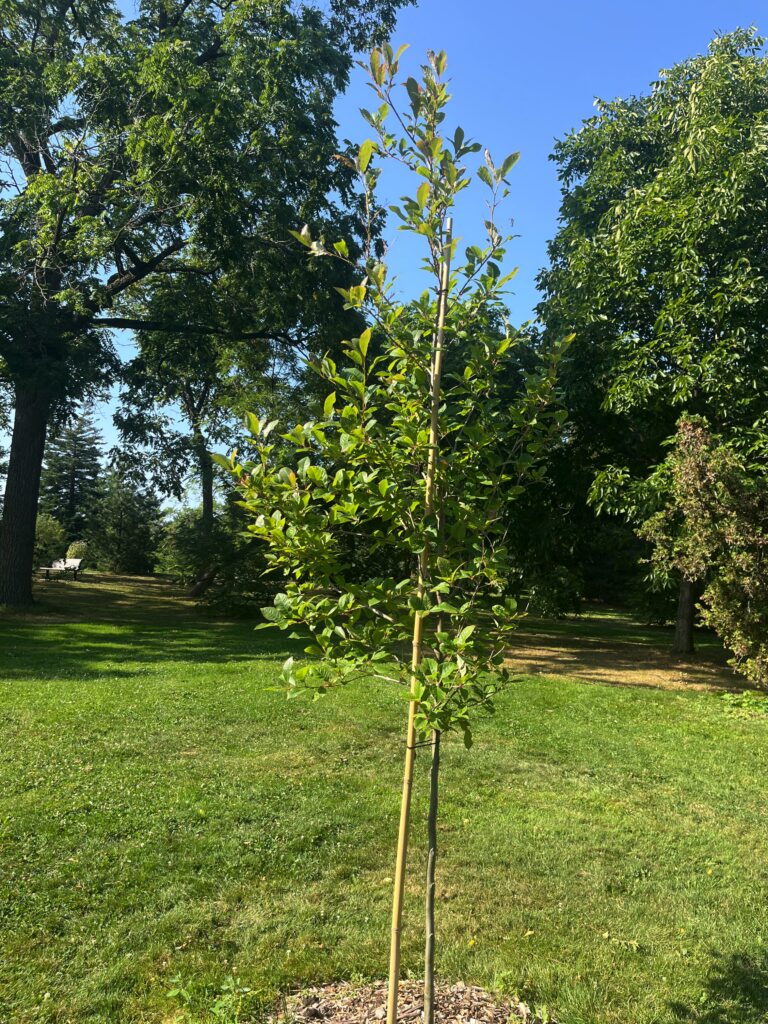
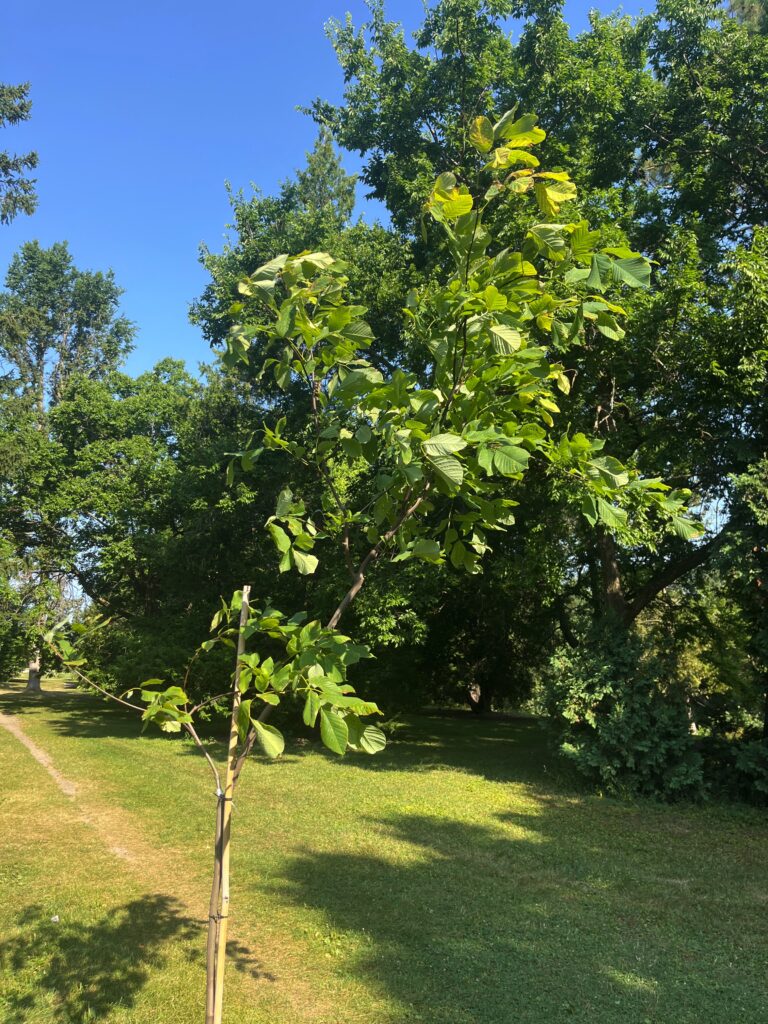
Yellowwood [2025] — Cladrastis kentukea — Yellowwood is native to the southeastern United States, although is rarely found there. Yet it is hardy much further north and deserves to be planted here more often. The tree is known mostly for its pretty white clusters of blossoms in spring and clear yellow leaves in the fall. The mature bark is smooth and gray, like a beech. The tree can grow to 15 metres tall. This tree is located on the outside edge of the Arboretum circle road, about 50 metres east of where the road turns into Building 72.
Zumi Crabapple [2025] — Malus ‘Zumi’ — The Zumi crabapple variety is a naturally-occurring hybrid that is often used for rootstock due to its salt tolerance and drought resistance. Several cultivars of this crabapple tree are also propagated and sold commercially. It’s known for its fragrant white flowers in the spring as well as its glossy fruit that attracts many birds. The tree can grow to about 5 to 10 metres tall. This tree is located near the parking lot at Building 72, just 25 metres west of the northwest corner of the lot.
